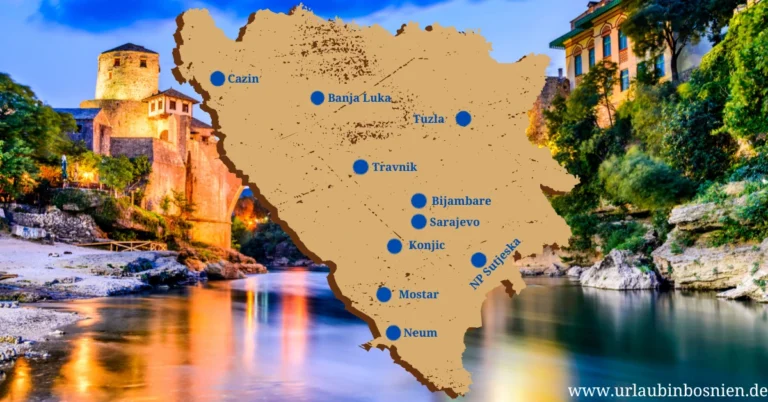Sarajevo's delicious cuisine
Welcome to Sarajevo, where the food will enchant your taste buds and leave you wanting more. Immerse yourself in the delicious taste of cevapi - juicy grilled minced meat - and you will immediately feel like you are transported to the Balkans. Enjoy the unique pleasures of stuffed onions and hearty pita pastries. Try the delicacy called burek, a special Bosnian pastry.
And don't forget to experience Sarajevo's vibrant coffee culture. Get ready to join us on a culinary journey in Sarajevo, where tradition and innovation meet on every plate. Bon appetit!

- Welcome to the culinary world of Sarajevo
- Cevapi: grilling fun Balkan style
- Burek: Delicious puff pastry from Bosnia
- Sarajevo's coffee experience
- Sogan-dolma: Bosnian-style stuffed onions
- Begova Corba: The noble soup of Sarajevo
- Bosanski Lonac: The Bosnian stew
- Japrak: Stuffed vine leaves from Bosnia
- Sarma: The art of cabbage rolls
- Dolmas and Dolmades: A Global Culinary Connection
- Baklava: Sweet layers of Bosnian tradition
- Pita pastries: savoury and sweet delicacy
- Traditional drinks of Sarajevo
- The street food culture of Sarajevo
- Cultural influences on Sarajevo cuisine
Welcome to the culinary world of Sarajevo
Are you ready to explore the diverse flavors and dishes in Sarajevo's culinary scene? Get ready for a culinary adventure. Sarajevo, the capital of Bosnia and Herzegovina, is a melting pot of different cultures and influences. This has resulted in a unique and vibrant food culture.
A particular highlight of Sarajevo's culinary scene is the rich tradition of street restaurants and street stalls. As you stroll through the busy streets, you'll smell the tantalizing aromas of grilled cevapi, skinless sausages cooked on open grills.
The juicy, aromatic cevapi are usually served in fluffy somun bread and topped with onions and a dollop of spicy kaymak, a local cream. And don't forget to try burek, a flaky pastry filled with meat, cheese or spinach. This hearty treat is perfect for making exploring the city a special experience.
When it comes to traditional Bosnian cuisine, Sarajevo is the place to be. You can't miss the opportunity to try Bosnian pita. This is a delicious pie made of thin dough and filled with various ingredients, such as meat, cheese or potatoes. The crispy outer layer combined with the tasty filling is a truly heavenly combination.
Another must-try is Bosnian bean soup, a hearty and warming soup made with beans, smoked meat and vegetables. This is the perfect dish to warm up on a chilly day in Sarajevo.
But Sarajevo's culinary scene is not limited to traditional Bosnian cuisine. The city also offers a wide range of international cuisines.
From Italian pasta to Turkish kebabs, everyone will find something to satisfy their hunger. The confluence of different culinary traditions makes Sarajevo a true paradise for the foodie.
Cevapi: grilling fun Balkan style

When you enjoy cevapi, you will understand why it is a Balkan delicacy. Cevapi, pronounced “che-va-pee,” is a traditional dish that originates from the Balkan region, particularly Bosnia and Herzegovina.
These small, finger-shaped sausages are made by mixing minced beef and lamb with various spices such as garlic, peppers and onions. This mixture is then formed into small sausages and grilled to perfection.
The great thing about cevapi is its simplicity. The combination of tender meat and aromatic spices creates a delicious experience that is hard to resist. Each bite is a hearty treat that will leave you wanting more. The meat is incredibly tender and juicy, thanks to the perfect ratio of fat and lean meat in the recipe.
Cevapi are traditionally served with somun, a Bosnian bread, and often garnished with chopped onions, sour cream and ajvar, which is a roasted pepper and eggplant spread. The contrast between the soft bread and the juicy grilled meat creates a delicious contrast that enhances the entire experience.
When you visit Sarajevo, you will find cevapi in numerous restaurants and street stalls throughout the city. It is a staple of Bosnian cuisine. Whether you enjoy it as a quick snack or a full meal, cevapi is a must. And your taste buds will thank you for eating this grilled Balkan specialty.
Burek: Delicious puff pastry from Bosnia

Be sure to try a slice of burek and experience the savory Bosnian-style puff pastry. Burek is a traditional Bosnian dish consisting of thin, flaky layers of dough filled with various ingredients. The most common fillings are meat, cheese, spinach, or a combination of these. The dough is rolled out thinly and then topped with the filling before being baked to perfection. The result is a deliciously crispy pastry with a soft and flavorful inner filling.
Your first bite into a piece of burek - and you'll be amazed by the taste. The flaky pastry melts in your mouth while the filling adds great flavor. The combination of textures is truly delicious. Whether you choose the meat-filled burek, which is particularly savory, or the cheese-filled burek, which is creamy and indulgent, each bite will make you more hungry.
Burek is actually a very simple dish that has been passed down from generation to generation and whose popularity, perhaps precisely because of its simplicity, has continued to grow over the past decades.
In Bosnian culture, burek is often eaten for breakfast or lunch, but can actually be enjoyed any time of day. It tastes best warm, straight from the oven, with the aroma of the burek filling the air.
If you ever get the chance to visit Bosnia, you should definitely try a piece of burek. It is a Balkan delicacy that you will never forget. In fact, it is the combination of burek's flaky pastry and its tasty fillings that will ensure you enjoy every bite.
Sarajevo's coffee experience

How about a cup of the famous Bosnian coffee from Sarajevo? Immerse yourself in the unique world of coffee with its special coffee aroma, which results from the special way it is prepared.
As you stroll through the streets of Sarajevo, you will be captivated by the tantalizing aroma of freshly brewed coffee. Sarajevo's coffee culture is deeply rooted in tradition and is an integral part of the city's daily life.
The method of preparing Bosnian coffee is very different from what you may be used to. It is prepared in a special copper pot called a “džezva” and served in small, handleless cups called “fildžani”. The coffee is brewed slowly to allow the aromas to fully develop and to produce a particularly aromatic coffee. The process requires patience and skill as the coffee actually needs to be boiled three times to achieve the perfect consistency.
When you take your first sip of Bosnian coffee, you will notice a rich and intense aroma, similar to that of Turkish coffee, and is often served with a sugar cube. The coffee is meant to be sipped slowly so that you can enjoy every moment and make coffee drinking a pure pleasure.
Sarajevo's coffee culture is not just about the drink itself, but also about the social aspect. When drinking coffee, people come together with friends and family, exchange ideas and enjoy each other's company. In the coffee houses, known as "kafanas", drinking coffee becomes a unique experience in a cozy and inviting atmosphere.
Sogan-dolma: Bosnian-style stuffed onions
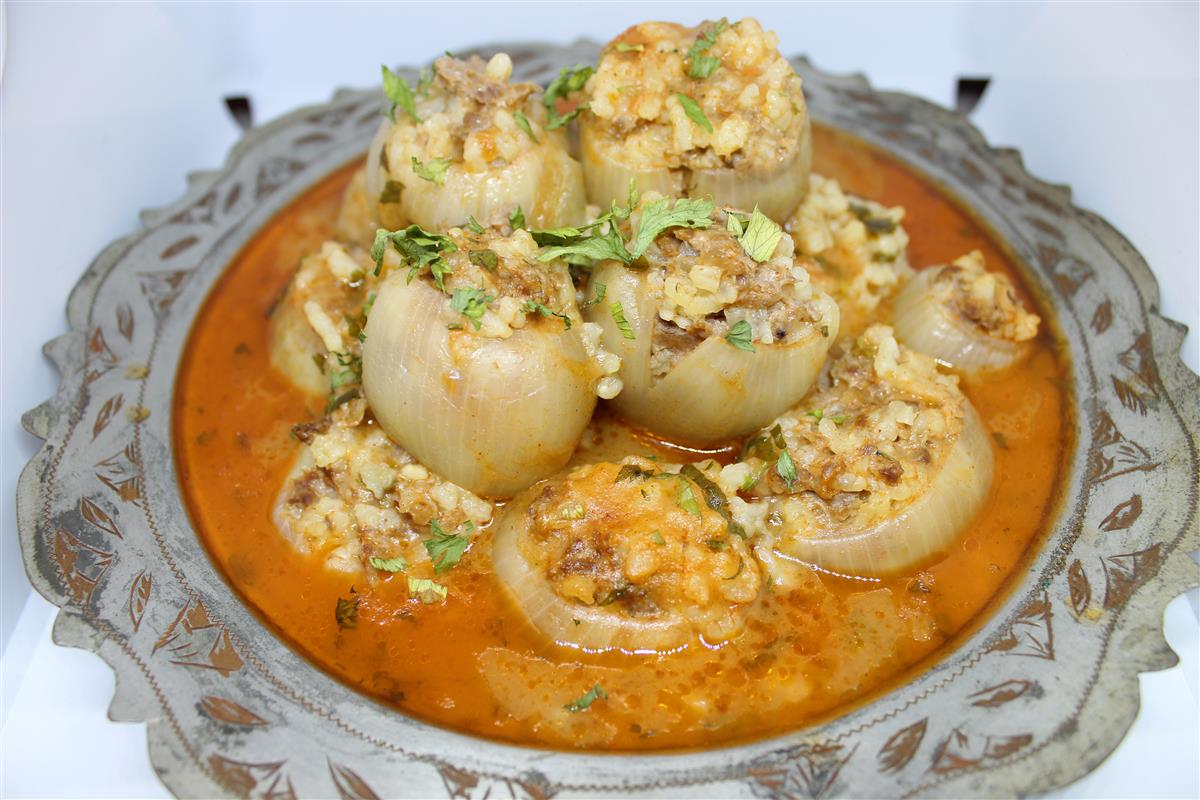
Have you ever tried Sogan dolma? It is a delicious dish made of stuffed onions. It is a traditional Bosnian dish that actually originates from the city of Sarajevo. The dish consists of large onions that are hollowed out and stuffed with a mixture of minced meat, rice and various spices. The stuffed onions are then slowly cooked in a flavorful tomato sauce until they are tender and infused with all the rich flavors.
It's a special taste experience - the combination of the juicy onion with the flavorful filling. This creates a harmonious blend of taste and texture, creating a balanced flavor profile that is truly incredibly satisfying.
What's great about sogan dolma is its versatility. Although it's usually made with ground beef, you'll also find variations that use lamb or even vegetarian fillings. This allows you to customize the dish to your personal preferences and possible dietary restrictions. Regardless of the filling, sogan dolma is a dish you're sure to enjoy.
Sogan dolma is not only delicious, but also has rich cultural significance in Sarajevo. It is often served on special occasions and celebrations and symbolizes prosperity and abundance. The dish is a true representation of the warm and hospitable nature of Bosnian cuisine.
Begova Corba: The noble soup of Sarajevo

You should definitely try Begova Corba, a soup that perfectly captures the essence of Sarajevo's culinary heritage. This traditional Bosnian soup combines flavors and warmth to create a real feast for the palate. Made with tender lamb, vegetables and fragrant spices, Begova Corba reflects the city's history and culture.
The origins of this noble soup date back to the Ottoman Empire, when it was served to the rich and powerful of Sarajevo. Today, it is a staple of Sarajevan cuisine, popular with locals and visitors alike. Making Begova Corba is a labor of love and requires hours of simmering to develop its signature, complex flavors.
When you take the first spoonful, you are greeted by the rich aroma of the lamb meat mingling with the earthy notes of the vegetables and warm spices. The tender pieces of meat melt in your mouth while the vegetables add a delicious crunch and freshness to every bite. The combination of flavors is truly harmonious, creating a symphony of flavors that will leave you wanting more.
Begova Corba is not just a soup, it's a culinary experience that takes you to the heart of Sarajevo. It represents the city's diverse cultural influences, blending Ottoman and Balkan flavors. So, if you're visiting Sarajevo, be sure to look out for this classic dish, because your taste buds will thank you.
Bosanski Lonac: The Bosnian stew
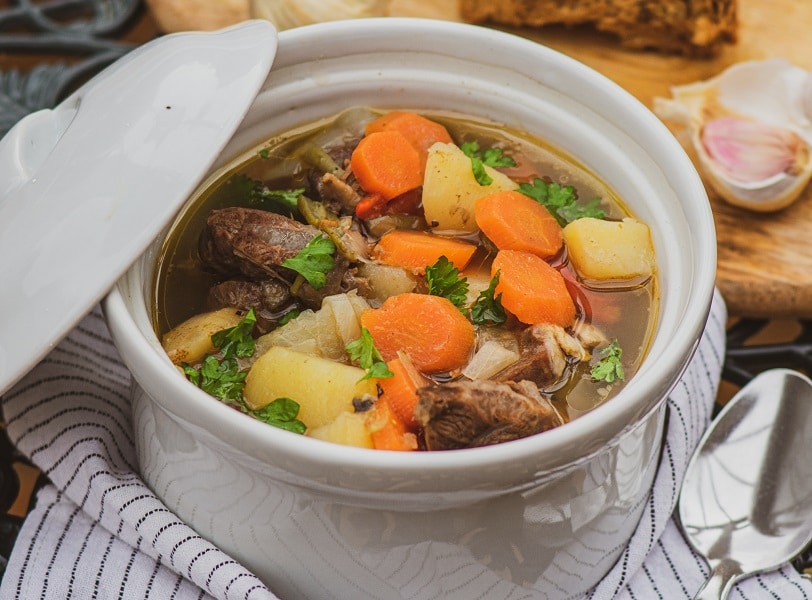
If you're hungry, order Bosanski Lonac, the tasty Bosnian stew. This traditional dish from Sarajevo is a true taste sensation. Made from a variety of meats, vegetables and spices, Bosanski Lonac is a hearty and filling meal that will warm you up on a cold day.
The name Bosanski Lonac means "Bosnian pot", which perfectly describes the way this dish is prepared. The ingredients are layered on top of each other in a large pot, starting with the pieces of meat such as beef, lamb or chicken. Then various vegetables such as potatoes, carrots and onions are layered on top, as well as some cabbage and peppers for the spicy touch.
What sets Bosanski Lonac apart from other stews is the cooking method. The pot is tightly closed and the ingredients are slowly heated and simmered over a low flame. This allows the flavors to blend and a unique aromatic broth to emerge. The meat becomes tender and juicy while the vegetables absorb all the delicious juices.
You will enjoy every bite of Bosanski Lonac. The combination of the different meats with the vegetables, which offer a fresh and earthy taste, as well as the spices such as paprika and black pepper, which give the stew a warm note, make Bosanski Lonac something really delicious.
This dish is not only delicious, but also has a special place in Bosnian culture. Bosanski Lonac is often prepared on festive occasions and family gatherings, bringing people together to enjoy good food in good company.
Japrak: Stuffed vine leaves from Bosnia
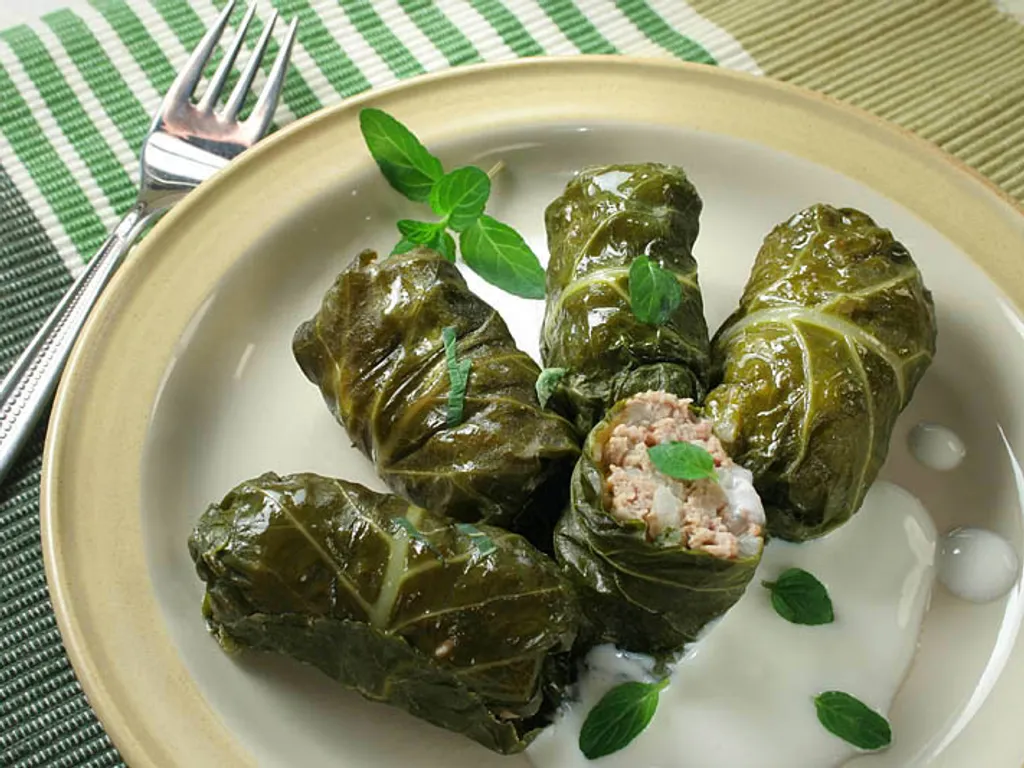
You should definitely try some japrak. These are stuffed vine leaves that are a delicious and unique appetizer. Japrak is a traditional Bosnian dish that consists of a tasty mixture of rice, minced meat, onions and various spices, which is wrapped in the leaves. The combination of the sour vine leaves and the savory filling makes for a special taste experience.
Japrak is quite time-consuming to make, but the end result is absolutely worth the effort. The grape leaves are carefully blanched to make them soft, and then each leaf is individually stuffed with the rice and meat mixture. The stuffed grape leaves are then rolled up tightly and cooked in a tasty broth until tender. During the cooking process, the individual flavors combine to create a special taste experience that you will want to repeat.
Japrak is often served with a dollop of sour cream or yogurt, which adds a creamy touch to the dish and balances the flavors. The combination of the tender grape leaves, tasty filling and creamy garnish creates a harmonious blend of textures and flavors.
Not only is japrak a delicious appetizer, but it is also a great way to experience the rich Bosnian culinary heritage. Every bite of japrak is like a journey through the country's flavors and traditions. So, next time you are looking for a culinary specialty, be sure to give japrak a try. You will not be disappointed.
Sarma: The art of cabbage rolls

Have you ever wondered how these cabbage rolls called Sarma create that magical combination of flavor and texture? Well, let me tell you: tender cabbage leaves are carefully wrapped around a tasty filling of ground meat, rice and certain spices. The rolls are then gently braised in a rich tomato sauce so that the flavors combine and your mouth starts to water as it cooks
Sarma is also easy to make. The acidity of the tomato sauce and the richness of the meat filling complement each other perfectly. The cabbage leaves provide a tender and slightly sweet base and add a refreshing crunch to each bite. Ultimately, it is the combination of textures that really sets Sarma apart and offers a pleasant mouthfeel
But it's not just the flavors and textures that make sarma special. It's also the sense of tradition and community that surrounds it. In Sarajevo, sarma is often prepared and enjoyed at special occasions and gatherings to bring families and friends together. It's a dish meant to be shared and enjoyed, creating unforgettable memories and deepening relationships.
Dolmas and Dolmades: A Global Culinary Connection

When it comes to exploring the global culinary connection of dolmas and dolmades, it is fascinating to see how these stuffed grape leaves have been enjoyed across different cultures throughout history. These delicious morsels are a testament to the creativity and inventiveness of different cuisines around the world.
Dolmas and dolmades are typically made by wrapping a mixture of rice, herbs and sometimes meat in grape leaves. The filling can vary depending on the region and personal preference, but the result is always a taste sensation in every bite. The combination of the tender grape leaves and the savory filling creates a harmonious balance that is simply irresistible.
In the Mediterranean region, dolmas are a staple in Turkish, Greek and Middle Eastern cuisine. They are often served as mezze or appetizers and can be enjoyed hot or cold. The sour flavors of the grape leaves are complemented by the earthy herbs and spices in the filling. Whether it's the rich lamb and rice filling in Turkish dolmas or the vibrant lemon and dill flavors in Greek dolmades, each bite is a special taste experience.
Dolmas and dolmades have also found their way to other parts of the world. In the Balkans, they are a popular dish in countries such as Bosnia and Herzegovina, Serbia and Croatia. These regions put their own twist on the dish, often using a combination of rice and minced meat as a filling. The result is a heartier version of the classic dolma, perfect for a filling meal.
No matter where you go, you'll find versions of dolmas and dolmades that reflect local culture and regional tastes. From the delicate and aromatic spices of the Middle East to the bold flavors of the Balkans, these stuffed grape leaves are a testament to the rich culinary heritage of different cultures. So the next time you find dolmas or dolmades on your plate, take a moment to appreciate the global culinary connection that unites people through food.
Baklava: Sweet layers of Bosnian tradition

Try a piece of baklava and you will experience the sweet and crunchy layers of Bosnian tradition. Baklava is a popular dessert in Bosnia, known for its rich flavors and delicate texture. Each bite is a heavenly combination of crispy filo pastry, sweet honey and ground nuts, usually walnuts or pistachios.
The origins of baklava can be traced back to the Ottoman Empire, where it was a staple in royal cuisine. Over time, it spread throughout the Middle East and the Mediterranean, with each region adding its own unique twist. In Bosnia, baklava is a symbol of hospitality and is often served at special occasions such as weddings and religious festivals.
Making baklava is a labor of love. Layers of buttered filo dough are stacked on top of each other, with ground nuts mixed with sweet syrup in between. After baking to golden perfection, the entire dessert is doused with sweet, runny honey syrup to marry the flavors together and create a decadent treat.
When you take your first bite, you are greeted by a satisfying crunch as you sink your teeth into the crispy dough layers. The sweetness of the honey syrup hits your taste buds, followed by the nutty richness of the ground nuts. The combination of textures and flavors is truly a delight for the senses.
Baklava is not just a dessert; it is a cultural experience. It represents the rich history and traditions of Bosnia, and every bite reminds you of the warmth and hospitality of the Bosnian people. So, the next time you have the opportunity to have baklava on your plate, don't hesitate to enjoy a piece of baklava and taste the sweet layers of Bosnian tradition.
Pita pastries: savoury and sweet delicacy
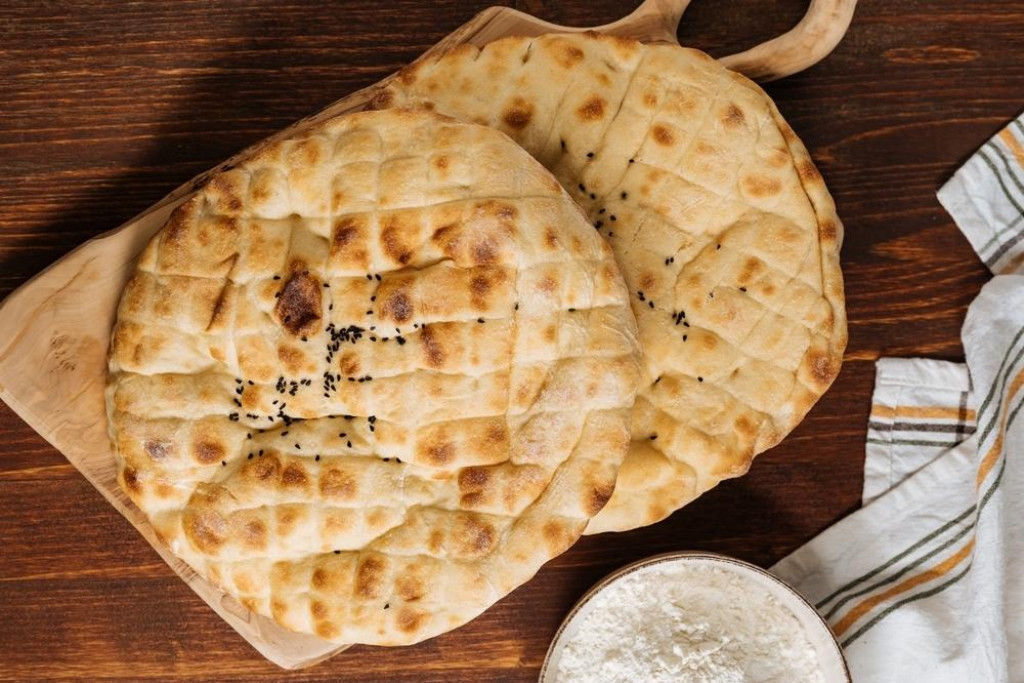
You can choose from seven different types of pita pastries, both savory and sweet, to satisfy your appetite. Whether you're in the mood for a hearty meal or a delicious dessert, Sarajevo's pita pastries have you covered. This flaky delicacy is a staple of Bosnian cuisine and is loved by locals and tourists alike.
One of the most popular savoury options is the cheese pita. Made from thin layers of dough filled with a blend of local cheeses, this pita is baked until golden brown. The combination of the crispy outer layer and the gooey, melted cheese inside is simply irresistible.
If you prefer meat pies, try the ground beef pita. Filled with seasoned ground beef and onions, it's bursting with flavor. The meat is tender and juicy, while the dough provides the perfect crispiness.
For those who prefer sweet things, the apple pita is a must. Sliced apples are mixed with cinnamon and sugar and then wrapped in thin layers of dough. The result is a heavenly dessert.
Another sweet option is the chocolate pita. A rich chocolate filling is wrapped in flaky dough, creating a decadent treat that will satisfy any chocolate lover.
No matter which pita you choose, you are in for a delicious Sarajevo dining experience. The combination of flavors and textures in these pastries is truly extraordinary. So, indulge in the savory and sweet delights of Sarajevo's pita and let yourself be transported to Bosnian culinary heaven.
Traditional drinks of Sarajevo

There are three traditional Sarajevo drinks that you should definitely try during your visit. First up is Bosnian coffee, a strong and aromatic drink that is an integral part of Bosnian culture. Served in a small copper kettle called a “džezva”, this coffee is slowly brewed over a tray filled with hot sand, resulting in a rich and flavorful cup of coffee. Take a sip and let the pleasantly strong taste transport you to the heart of Sarajevo.
Next on the list is the refreshing and sour homemade lemonade. Made from freshly squeezed lemons, sugar and sparkling water, this tangy drink is perfect for quenching your thirst on a hot summer day. It's a simple yet delicious drink that locals love to enjoy during picnics or strolls through the charming streets of the city. The lemony freshness will refresh you and leave you feeling revitalized.
And then we have rakija, a traditional fruit brandy popular throughout the Balkans. Sarajevo is known for its high-quality rakija, made from various fruits such as plums, apples or pears. This strong liquor is usually enjoyed as an aperitif or digestif, and its smooth and bold flavor is sure to leave a lasting impression. Whether you sip it slowly or drink it as a shot, rakija is a drink you should try and will also give you an insight into the local culture.
The street food culture of Sarajevo

Have you ever tried the delicious Ćevapi from Sarajevo's street food culture, with their succulent grilled meat and warm, fluffy bread? If not, you are missing out on a true culinary delight. Sarajevo, the capital of Bosnia and Herzegovina, is known for its rich and diverse street food culture. As you stroll through the bustling streets, the tantalizing aroma of grilled meat fills the air, inviting you to sample the delicious offerings.
One of the most popular items in Sarajevo's street food culture is Ćevapi. These small, finger-length sausages are made from a mixture of beef and lamb, seasoned with a blend of spices that give them their unique flavor. The meat is grilled to perfection and has a smoky, slightly charred outer layer and is tender and juicy on the inside. Served in a warm, fluffy bread called somun, Ćevapi are usually served with onions and a dollop of kajmak, a local cream. The combination of flavors and textures is simply divine.
When you take your first bite, you can't help but be overwhelmed by the flavor. The smoky, savory flavor of the grilled meat combined with the soft and slightly chewy texture of the bread creates a harmonious balance that is truly satisfying. The onions add a refreshing crunch, while the creamy kajmak sauce adds a velvety, creamy richness that ties it all together. Every bite is a delight and leaves you wanting more.
Sarajevo's street food culture is a true reflection of the city's vibrant and diverse culture. It is a testament to the culinary traditions that have been passed down through generations. So, when you find yourself in Sarajevo, make sure you buy some delicious Ćevapi from the street vendors. Trust me, it will be an experience you won't soon forget.
Cultural influences on Sarajevo cuisine
If you visit Sarajevo frequently, you will notice the strong cultural influences on the city's cuisine. Sarajevo, the capital of Bosnia and Herzegovina, is a melting pot of different cultures and traditions. This diversity is reflected in the delicious and varied dishes you can find in the city. The culinary scene in Sarajevo is a beautiful blend of Ottoman, Austro-Hungarian and Balkan influences, which has produced a unique and delicious cuisine.
One of the most prominent cultural influences on Sarajevo's cuisine is its Ottoman heritage. The Ottomans ruled Bosnia for centuries, and their culinary traditions left a lasting impression.
When visiting Sarajevo, be sure to try some Bosnian kebabs known as “Ćevapi”. These small grilled meat sausages are usually served with flatbread, onions and a side of sour cream called “kajmak”. Another Ottoman-influenced food is “burek”, a flaky pastry filled with meat, cheese or spinach. It is a popular street food that you can find in many bakeries around the city.
Austro-Hungarian rule also left its mark on Sarajevo's cuisine. If you're a fan of pastries, you're in for a treat. Sarajevo is famous for its 'baklava', a sweet pastry made of layers of filo dough, nuts and sweet syrup. The Austro-Hungarian influence is also evident in dishes such as 'goulash', a hearty stew made of meat seasoned with paprika and served with bread or pasta.
Finally, the Balkan influence on Sarajevo's cuisine cannot be overlooked. Grilled meat is a staple of Balkan cuisine, and Sarajevo is no exception. Don't miss out on trying "pljeskavica," a tasty beef patty usually served in a bun with various toppings.
No matter which direction you turn in Sarajevo, you will find dishes that reflect the city's culinary diversity and richness. Locals are proud of their culinary tradition and are happy to introduce visitors to the delicious flavors and rich history of their dishes. Sarajevo is truly a foodie's paradise where you can take a culinary journey through the centuries.


